Newswise Article on HLP
11/21/08 12:02
High-Altitude Lakes Studied as Global Warming "Hot
Spots"
http://www.newswise.com/articles/view/546652/
http://www.newswise.com/articles/view/546652/
Captain's Log No. 5 - A New Universe Unfolds
11/20/08 11:25
November 18-20, 2008
The previous days have been very cold with high winds and low temperatures. Macario and some of the porters reported the summit lake of Simbad being, in great part, frozen as they visited the crater a few times for equipment rotations. If the lake is frozen, that will limit the amount of science we can do up there this year. Simbad is certainly a tough volcano to get to, to stay on and to study. Its proximity with Lascar makes it dangerous as well; we cannot build a summit camp anywhere near the summit. Lascar vents continuously, most of the time water vapor but from time to time, sulfuric acid as well. Not a good place to be if the clouds sink into Simbad’s crater. Our mid-camp is half-way on the slope, leaving us with 600 m to climb on summit day and a few hours only to focus on science before descending. This ascent is hard in scree and ash. I’ll have to think about something for the future. Maybe a small camp below the red rocks about 40 minutes from the summit would do the trick. They are on the opposite side of Lascar and somewhat protected. That’s for the volcano itself but for now, I have other worries in mind.
Up to now, Edmond was among the very few not being hit by some sort of bug during this expedition. That’s not the case anymore. On the day planned for our ascent to mid-camp (November 18), he wakes up complaining of abdominal pain and nausea. Considering the history here, we cannot take any chance. This is a trip to the Calama hospital, four hours away. That means that our doctor is going with him and that we will have to wait for her return to go up. She should be back by the end of the day.
I see the car leaving the camp and disappearing on the horizon. I have to be with the team and organize an impromptu day of science. Some of the crew will take advantage of this additional day to finish their science at Lagunas Lejia and Aguas Calientes. The logistics team now has a bit more time to finish the preparation for the ascent with only tomorrow left for the team to start the ascent. This is our last buffer day. Once everyone is organized, I go back to my tent, my thoughts wandering beyond the altiplano, somewhere on a road between Chillyfornia and Calama.
The day unfolds, windy but eventless after that. Jeremy and Kevin are happy with their experiments. Lee and Cookie have joined them. They are back a little after one o’clock; I am sorting out the last details of the ascent with Cristian. Claudia should be back from Calama tonight around 8:00 pm. If Edmond is fine, he will stay in San Pedro to recover. He did not plan to climb this year anyway and his stay in San Pedro was on our schedule. However, it was not planned for him to be there and sick. Now, if he needs to stay in hospital, then, Victor will go there to be with him. He offered this without hesitation. The reason he gave me was that he has family in Calama. He smiles…He knows. We have known each other for too long and I cannot hide my thoughts from him and do not want to. He just points at the guys and the mountain and then points at me and back at the mountain…Nice short cut. He wants me up there. His friendship touches me deeply.
It is not even dinner time when Claudia is back. She was fast and news is good. It is only a bacterial infection, nothing really serious. A few days of antibiotics and Edmond will be fine. Some of the team members have shown symptoms in the past few days and it is a bit depressing to see this thing propagating although we are doing our best to maintain good hygiene. I suppose that a weakened immune system at high altitude is to blame more than anything else. Edmond will recover in San Pedro while we climb. Victor can stay with us and I feel a bit better. We plan to call Edmond tonight. Apparently, he was better already before arriving to the ER department and actually stopped at the hotel in San Pedro to take a shower before heading to Calama… I can’t help but laugh after all this worry. At least, he is fine.
Tomorrow we go up. Night falls on Chillyfornia. The next one will be spent at mid-camp. From tomorrow on, we will be climbing, sleeping, and working on that mountain. Two hard days are in sight. I see the backpacks getting ready near the tents. I’ll finish mine tomorrow. Not too much to add in it. We will still have to take our sleeping bags and a blanket but for now, we certainly can use them in the tents.
It is as cold as ever. I get out of the dinning tent. Everything is dark in the camp. The crew is in bed early, most likely thinking about tomorrow, I assume. I had hoped to talk to Edmond tonight but the satellite phone is disconnected and the generator off. I do not want to wake up everybody. I get in the tent, strangely quiet. I have placed Bongo and GB in Edmond’s sleeping bag. Tomorrow, I’ll take them with me and hopefully the day after tomorrow, they will be at the summit with us. Those two little mascots have accompanied us every single expedition. I look at them; I smile, but still, they cannot fill the empty space tonight.
November 19 - I talk to Edmond in the morning. His voice is tired or maybe this is just the satellite phone but my worries are back and that puts me in a dark mood. Getting ready to go up is hard when so much is calling me down in San Pedro. I’ll have to make that choice clear in my head really fast. By 10:00 am, the pick ups are here and we pile up on equipment on the flat beds. The ascent team is composed of me, Cookie, Claudia, Jeremy, Jut, Kevin, Eric, Gordon, Cristian, and Victor (who will stay at mid-camp for logistical support). Macario will guide us and will climb with three porters to the summit while two others will break camp at mid-slope with Victor as we are going up.
We are following the same dirt trail with the pick up trucks as during training day. We should be a little slower than during that day because our personal load is heavier but we have lots of time in front of us and this is a good feeling. No rush. Juan, the driver of our car, is once again displaying all of his talent, to the point that I am asking if he really plans to take us to the summit with the car. He stops at 4,800 m and it’s finally time to get out. The team is spread between the three cars and not all of those made it as high as ours. We will have to wait for them. Meanwhile, Gordon, already camera rolling, has climbed a bit more to catch us starting on the slope. That takes another 20 minutes but we are finally all on our way, one long line. Macario is first, I am behind him and I already have locked my eyes on his footsteps.
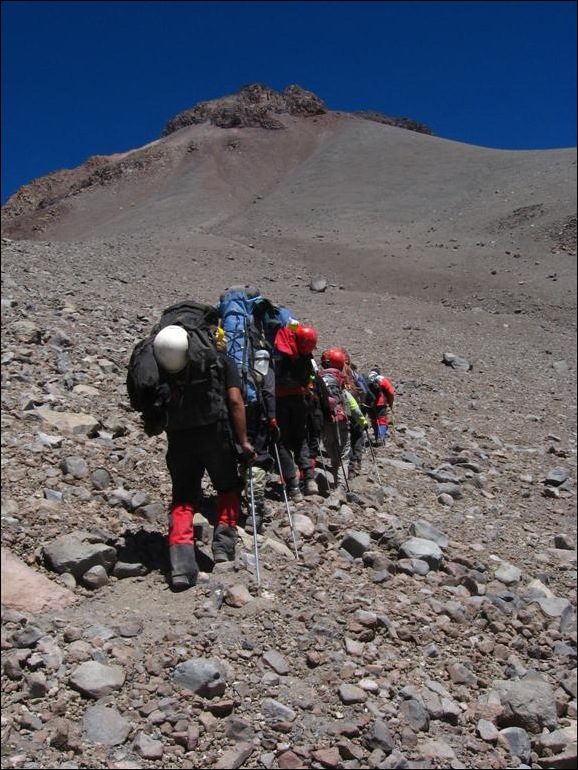
The team on its way up to Simbad, November 19th
This team has rhythm. I already could see that during training but today, everybody is again doing well, to the point that it takes us only 30 minutes more to reach mid-camp than two days ago, with additional load. We also stopped a few times. We reach camp around 3:00 pm and start setting up the tents. This is not the vast summit camp of Licancabur. Each tent is nested on a small space that was flattened for that purpose and we have barely the space to fit each tent’s footprint.
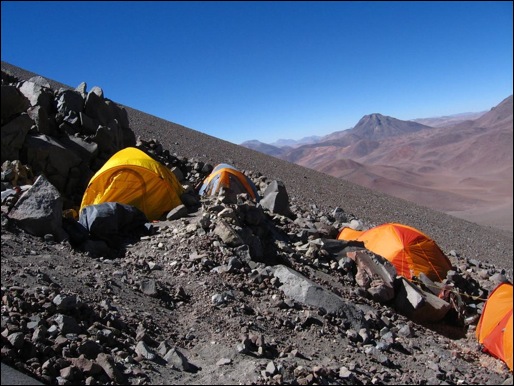
Mid-camp
The view is breathtaking (literally ☺!). I open my backpack to see that Bongo and GB are here and my mind wanders back to San Pedro. Hope everything is okay down there. I get into the tent that I share with Jut. He is helping out somewhere else. I can use some time for myself. The temperature is also falling pretty fast. I grab something quick to eat and drink and just rest. A couple of hours possibly pass before Jut comes back to settle down for the night. In the meantime, I shared some thoughts with Claudia. Now it is time to try to sleep. Unfortunately, the emphasis for most everyone tonight will be put on “try”.
November 20 - I lost track of how many times I woke up, maybe 30, 40 (??), how many weird dreams I had. This is the strangest night I ever had at altitude. When we talk in the morning, I realized that this experience was shared by most of us. Claudia has a theory. Apparently, the barometric pressure went down 200 mb last night as a storm was cruising nearby in Argentina and clouds were surrounding us. This means that, although mid-camp is at 5,400 m (5,363 m to be precise), the atmospheric pressure was equivalent to that of over 6,000 m, a rather big jump when trying to acclimatize. Net result: little headache, little seasickness, and little stomach ache. Right now, I do not want to get out of the tent. For the first time in seven years, I am contemplating the real possibility of staying at mid-camp and not make the summit. I ask for a couple of Tylenol, an antispasmodic for my stomach and start drinking everything I find i.e. tea, juice. Getting liquids down is an issue. I do not even want to think about food at this point. One hour after waking up, I am still in the mode of staying at camp. In the meantime, Macario and the porters have arrived. There is still time. They need to have breakfast and I need to think about how I want to deal with this. I feel sick and I know that it is better for the team that I stay here if this does not improve rather than becoming a problem somewhere on the slope.
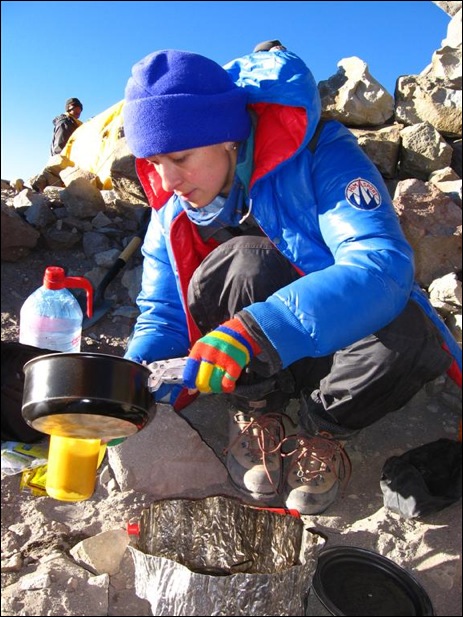
Claudia preparing breakfast at mid-camp, 11/20
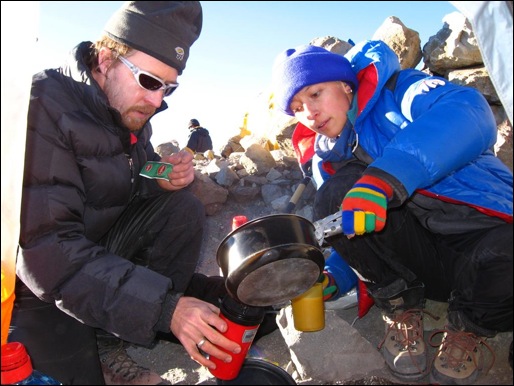
Claudia and Jut at breakfast;
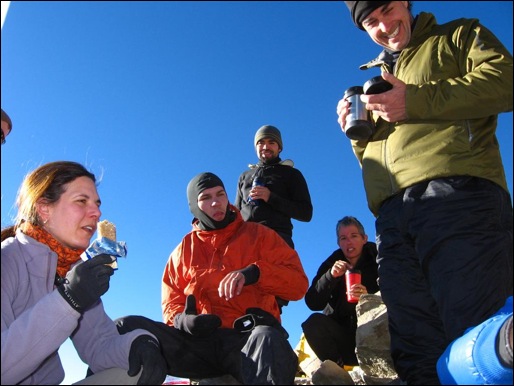
Breakfast time for the team, from l to r: Ingrid (a.k.a Cookie), Kevin, Eric, Nath, and Gordon
Another 30 minutes pass and there is some improvement. I do not feel all that strong but the overall feeling is better. Maybe I will give it a try. If that does not hold, then, I can get back down to mid-camp which is easy to reach. It is 9:00 am when we start our way up. As usual, I am behind Macario who has taken my backpack and does not seem to be willing to give it back to me. I never asked for that as I am used to carry my load but Macario is most likely right. With that on my back today, it is unlikely that I could make it to the summit and he probably knows it better than anybody else. I have known him for a long while too. Wherever I turn, I see friends and their support. No matter what or how I feel, this is the best adrenaline shot in the world. Claudia had a rough night too and Eric and Jut are still a tired. We go up. I have to admit that in the first hour, I probably thought about going down a couple of times. But then, there is always the next step, the next switchback, still the possibility of feeling better. I haul myself to the red rocks this way. In the previous hour, I have started to be able to drink more at once. I take this as a good sign. I am on electrolytes thanks to Claudia. They do not taste all that good but they are getting the job done. I am still here and feeling better, light, but better.
We stop at the red rocks for a little while. That gives everyone the time to catch their breath, hydrate, and for those who want/can, eat something. We are only 40 minutes away from the summit and I start to believe I can make it.
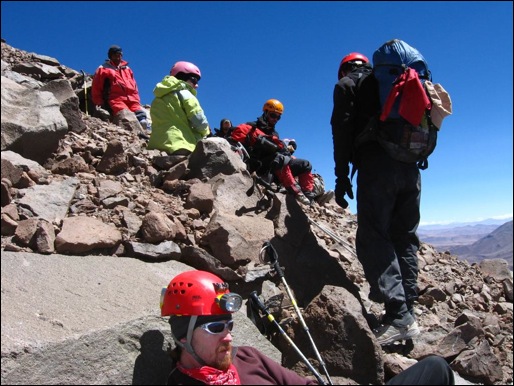
The team taking a break in the red rocks, from foreground to background: Jut, Kevin (standing), Ingrid, Eric, Macario, and Nath
We are on our way again. The summit is now a reality.
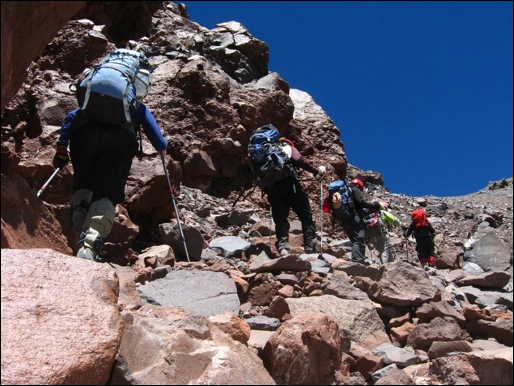
The team arrives near the summit of Simbad at about 12:30 pm, November 20th
The whole team is making it and that’s definitely a highlight considering all that we went through. Eric has some difficulty about 20 minutes away from the goal and needs a little bit of assistance from Claudia to get back on track. Both will meet us at the summit within 15 minutes escorted by Cristian who closes the trail. We are there, all of us. I feel deeply happy for Jut who had such rough start, for Jeremy, Kevin, and Eric, for whom this is their first summit that high. Cookie is having a great day as is Cristian. Macario is showing a thumb up. It took us only three hours and half to reach summit from mid-camp – and we stopped --. This is our best time ever, which means more time for science. However, this will mostly depend on the lake, not on us.
I now walk the little ridge that still hides the lake from me. I get to the top and look down. What I see just finishes uplifting my spirit and rewards us for all the difficulties we had. The lake is mostly thawed, keeping a center core of ice glittering like diamonds surrounded by ruby red, almost purple, waters.
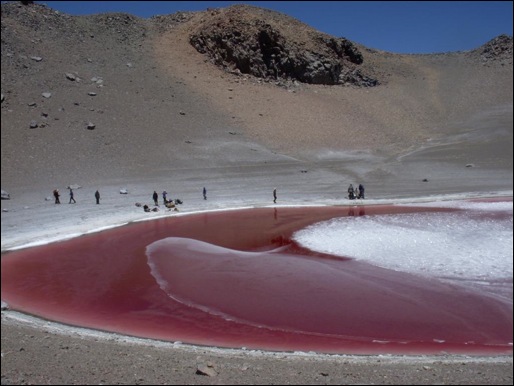
The summit lake from the rim of Simbad
I do not know who to thank for that but I give thanks anyway. We spend 5 minutes for photos, we deserve it. I also ask Cookie to take a photo of GB and Bongo with the lake in the background. They are not so foreign to the fact that I made it to the top. Usually, that’s Edmond who carries them in his backpack.
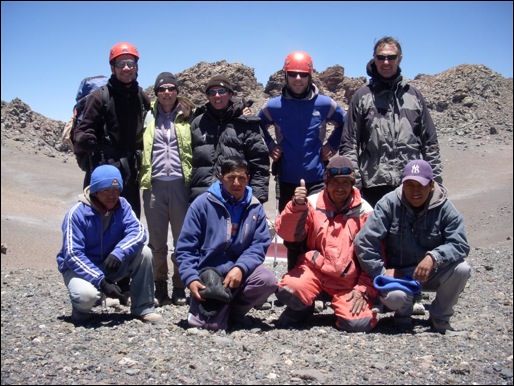
The first part of the team at the summit
They are soon joined by;
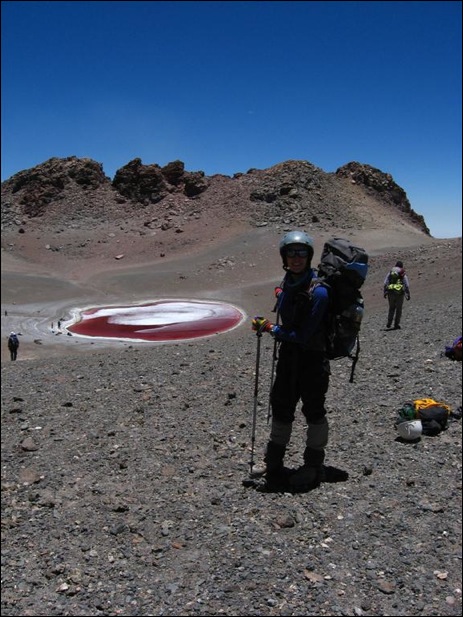
Claudia
and
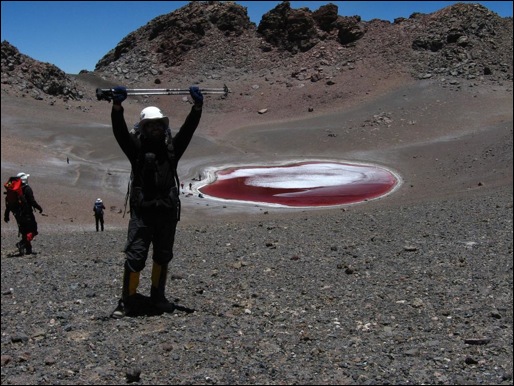
Cristian and Eric (lower left)
We will stay close to three and a half hours at the summit and complete all the science we could that day. Jut is launching the Eldonet UV dosimeter successfully with the help of Cristian and Gordon.
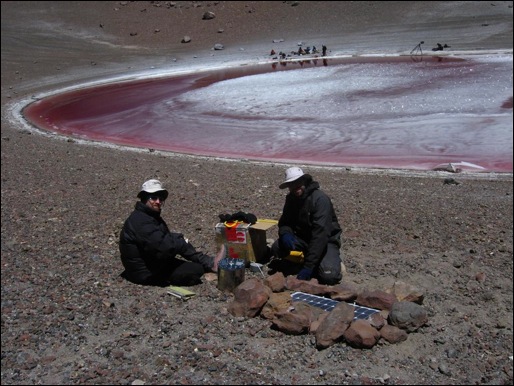
Jut (left) and Cristian (right) launching the UV dosimeter
Jeremy is collecting samples and Kevin tries unsuccessfully to boot his computer. The low pressure at 5,870 m is playing tricks on the system and there is nothing that Kevin can do about it, and that means that will we have to do the UV profile of the water with the water samples back at home.
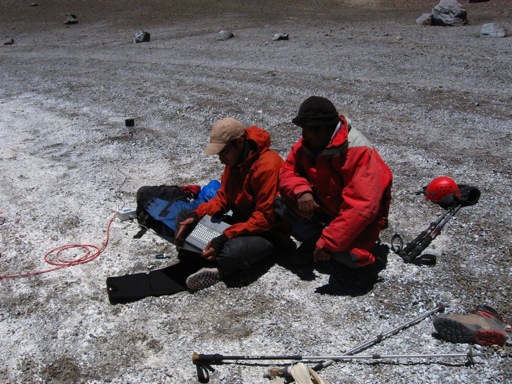
Kevin tries unsuccessfully to boot his computer with Macario watching
I have donned the waders and entered the purple water. I am taking water samples.
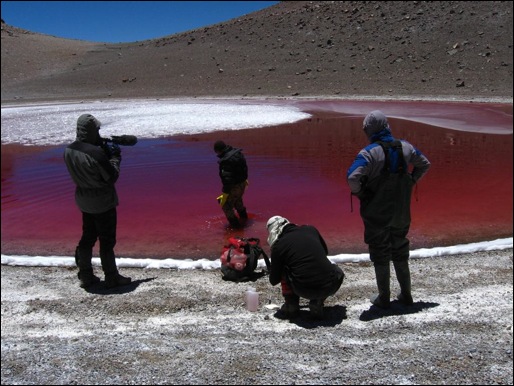
Nath entering the lake while Gordon (left) is filming from the shore. Eric is logging information about the water samples and Jeremy (right) monitors the operation
As I do this, I cannot help but notice that the red of the water is from particulates in suspension, billions of them. What are they? It is hard to imagine something mineral that could stay suspended and not dissolve. Maybe these are tiny living creatures, in which case, there is a serious crowd out there and that would make Simbad’s summit lake of top ranking scientific interest. I keep sampling. Eric passes me the bottles. Interestingly, the first 50 cm of shallow waters from the shore do not show any of these particulates and the water is completely transparent. Despite the altitude, my brain starts to click a bit and I am listing hypotheses, each of them more exciting than the previous.
Once I get all the water samples, I start looking at the sediment and…bingo! The first layer has the color and consistency of egg white and is few millimeter thick. Pass this layer and there is a lot of green, which I believe to be algae but the microbiologists will have the last word on that. There is also a pink layer in between that could be bacteria.
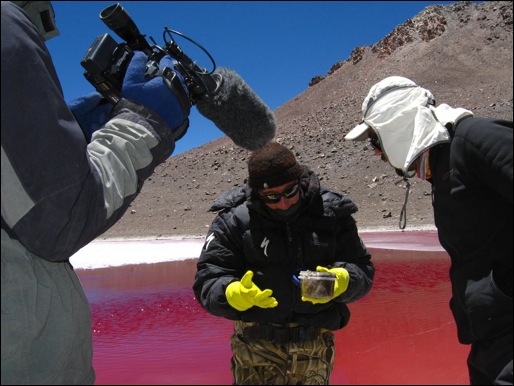
Nath discussing the content of the sediment samples with Eric. Gordon still filming…
There is also a strong odor of sulfur coming out of this but I keep sampling. The crater is buzzing from all the activity. My head is buzzing too and my balance is hard to find. While I drank a lot, I was not able to eat anything since last night, which was already not that much. Dizziness is catching up with me while I am in the water. I walk slowly out and sit for a while and things are better within a few minutes. Claudia is joking but keeping an eye on everybody. She does not want to have to fish me in the middle of the lake and I can certainly understand that. The pH is 5.5 (higher than last year’s 3.9) and the temperature of the water is 8.3C. There are better places to take a bath.
Gordon films what he can and is running from one place to the next. He also gives a hand to install the Eldonet dosimeter. It is already getting late. It will take us close to two hours to return to the foot of the volcanoes where the cars wait. We cannot get caught by the night fall and cold on that slope as we need to exit through a ~50 degree sloping gully. Still, all of our findings are so exciting that it is with a heavy heart that I pull the plug at 3:30 pm. It is even harder because for the first time in the 3 years we have visited this volcano, there is absolutely no wind in the crater and the temperature is actually relatively mild. It is hard to leave in these conditions but we have no choice. Another hour and we would be in trouble on the slope.
We gather as much equipment as possible and leave. What we could not carry today down the slope, Macario and a couple of porters will come to retrieve tomorrow.
We leave the crater with a sense of achievement. We’ve come a long way to make this summit. This expedition was very challenging in many respects. We also know that we do have exceptional samples in our bags and because of the proximity they will be at the University in Antofagasta in less than 2 days, and therefore in excellent condition to start their analysis. We will finally know what they are.
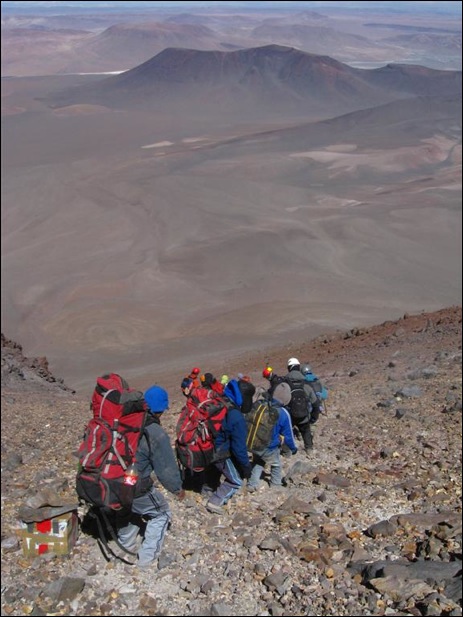
The team leaves the summit crater with regret around 3:30 pm, November 20th
We jump in the gully. Gordon captures with his camera the backlit slope and the dust around us as we are descending, like skiers in powdery snow. We reach mid-camp where Victor has been waiting for us at 4:40 pm, very fast. Stopping there was a mistake, though, as far as I am concerned. The last 30 minutes of descent will be very hard. I believe I could add some definition to the word “tired”. Each step in the last 500 meters is excruciatingly hard and I’m almost nauseous. It is 5:20 pm when we reach the car. Below the crust of dust that covers us, we are only smiles. We made it. A station is logging again up there at the summit, we retrieved that of last year, and we have brought back very exciting samples.
The news gets even better than that. At camp, we receive two messages that complete that day in a uplifting way: (a) Edmond is doing great and will come up with a pick up tomorrow to help us break camp at Chillyfornia. We will all go back to San Pedro together; (b) David and Benita have cooked a wonderful soup and chicken dinner tonight! The dinner table is buzzing with laughter and tales, memories this group now shares, that of an ascent and a mission they made successfully together. As night falls, I head back to my tent. It is still early but I can use some sleep. My backpack is outside the tent. I open it: GB and Bongo are there. I put them back in Edmond’s sleeping bag and I get to mine. I look at them. Tonight they fill that space in my heart with joy. Tomorrow, their “dad” will come to pick us up and we will all get down the mountain together.
Good night from up high,
Nath
The previous days have been very cold with high winds and low temperatures. Macario and some of the porters reported the summit lake of Simbad being, in great part, frozen as they visited the crater a few times for equipment rotations. If the lake is frozen, that will limit the amount of science we can do up there this year. Simbad is certainly a tough volcano to get to, to stay on and to study. Its proximity with Lascar makes it dangerous as well; we cannot build a summit camp anywhere near the summit. Lascar vents continuously, most of the time water vapor but from time to time, sulfuric acid as well. Not a good place to be if the clouds sink into Simbad’s crater. Our mid-camp is half-way on the slope, leaving us with 600 m to climb on summit day and a few hours only to focus on science before descending. This ascent is hard in scree and ash. I’ll have to think about something for the future. Maybe a small camp below the red rocks about 40 minutes from the summit would do the trick. They are on the opposite side of Lascar and somewhat protected. That’s for the volcano itself but for now, I have other worries in mind.
Up to now, Edmond was among the very few not being hit by some sort of bug during this expedition. That’s not the case anymore. On the day planned for our ascent to mid-camp (November 18), he wakes up complaining of abdominal pain and nausea. Considering the history here, we cannot take any chance. This is a trip to the Calama hospital, four hours away. That means that our doctor is going with him and that we will have to wait for her return to go up. She should be back by the end of the day.
I see the car leaving the camp and disappearing on the horizon. I have to be with the team and organize an impromptu day of science. Some of the crew will take advantage of this additional day to finish their science at Lagunas Lejia and Aguas Calientes. The logistics team now has a bit more time to finish the preparation for the ascent with only tomorrow left for the team to start the ascent. This is our last buffer day. Once everyone is organized, I go back to my tent, my thoughts wandering beyond the altiplano, somewhere on a road between Chillyfornia and Calama.
The day unfolds, windy but eventless after that. Jeremy and Kevin are happy with their experiments. Lee and Cookie have joined them. They are back a little after one o’clock; I am sorting out the last details of the ascent with Cristian. Claudia should be back from Calama tonight around 8:00 pm. If Edmond is fine, he will stay in San Pedro to recover. He did not plan to climb this year anyway and his stay in San Pedro was on our schedule. However, it was not planned for him to be there and sick. Now, if he needs to stay in hospital, then, Victor will go there to be with him. He offered this without hesitation. The reason he gave me was that he has family in Calama. He smiles…He knows. We have known each other for too long and I cannot hide my thoughts from him and do not want to. He just points at the guys and the mountain and then points at me and back at the mountain…Nice short cut. He wants me up there. His friendship touches me deeply.
It is not even dinner time when Claudia is back. She was fast and news is good. It is only a bacterial infection, nothing really serious. A few days of antibiotics and Edmond will be fine. Some of the team members have shown symptoms in the past few days and it is a bit depressing to see this thing propagating although we are doing our best to maintain good hygiene. I suppose that a weakened immune system at high altitude is to blame more than anything else. Edmond will recover in San Pedro while we climb. Victor can stay with us and I feel a bit better. We plan to call Edmond tonight. Apparently, he was better already before arriving to the ER department and actually stopped at the hotel in San Pedro to take a shower before heading to Calama… I can’t help but laugh after all this worry. At least, he is fine.
Tomorrow we go up. Night falls on Chillyfornia. The next one will be spent at mid-camp. From tomorrow on, we will be climbing, sleeping, and working on that mountain. Two hard days are in sight. I see the backpacks getting ready near the tents. I’ll finish mine tomorrow. Not too much to add in it. We will still have to take our sleeping bags and a blanket but for now, we certainly can use them in the tents.
It is as cold as ever. I get out of the dinning tent. Everything is dark in the camp. The crew is in bed early, most likely thinking about tomorrow, I assume. I had hoped to talk to Edmond tonight but the satellite phone is disconnected and the generator off. I do not want to wake up everybody. I get in the tent, strangely quiet. I have placed Bongo and GB in Edmond’s sleeping bag. Tomorrow, I’ll take them with me and hopefully the day after tomorrow, they will be at the summit with us. Those two little mascots have accompanied us every single expedition. I look at them; I smile, but still, they cannot fill the empty space tonight.
November 19 - I talk to Edmond in the morning. His voice is tired or maybe this is just the satellite phone but my worries are back and that puts me in a dark mood. Getting ready to go up is hard when so much is calling me down in San Pedro. I’ll have to make that choice clear in my head really fast. By 10:00 am, the pick ups are here and we pile up on equipment on the flat beds. The ascent team is composed of me, Cookie, Claudia, Jeremy, Jut, Kevin, Eric, Gordon, Cristian, and Victor (who will stay at mid-camp for logistical support). Macario will guide us and will climb with three porters to the summit while two others will break camp at mid-slope with Victor as we are going up.
We are following the same dirt trail with the pick up trucks as during training day. We should be a little slower than during that day because our personal load is heavier but we have lots of time in front of us and this is a good feeling. No rush. Juan, the driver of our car, is once again displaying all of his talent, to the point that I am asking if he really plans to take us to the summit with the car. He stops at 4,800 m and it’s finally time to get out. The team is spread between the three cars and not all of those made it as high as ours. We will have to wait for them. Meanwhile, Gordon, already camera rolling, has climbed a bit more to catch us starting on the slope. That takes another 20 minutes but we are finally all on our way, one long line. Macario is first, I am behind him and I already have locked my eyes on his footsteps.

The team on its way up to Simbad, November 19th
This team has rhythm. I already could see that during training but today, everybody is again doing well, to the point that it takes us only 30 minutes more to reach mid-camp than two days ago, with additional load. We also stopped a few times. We reach camp around 3:00 pm and start setting up the tents. This is not the vast summit camp of Licancabur. Each tent is nested on a small space that was flattened for that purpose and we have barely the space to fit each tent’s footprint.

Mid-camp
The view is breathtaking (literally ☺!). I open my backpack to see that Bongo and GB are here and my mind wanders back to San Pedro. Hope everything is okay down there. I get into the tent that I share with Jut. He is helping out somewhere else. I can use some time for myself. The temperature is also falling pretty fast. I grab something quick to eat and drink and just rest. A couple of hours possibly pass before Jut comes back to settle down for the night. In the meantime, I shared some thoughts with Claudia. Now it is time to try to sleep. Unfortunately, the emphasis for most everyone tonight will be put on “try”.
November 20 - I lost track of how many times I woke up, maybe 30, 40 (??), how many weird dreams I had. This is the strangest night I ever had at altitude. When we talk in the morning, I realized that this experience was shared by most of us. Claudia has a theory. Apparently, the barometric pressure went down 200 mb last night as a storm was cruising nearby in Argentina and clouds were surrounding us. This means that, although mid-camp is at 5,400 m (5,363 m to be precise), the atmospheric pressure was equivalent to that of over 6,000 m, a rather big jump when trying to acclimatize. Net result: little headache, little seasickness, and little stomach ache. Right now, I do not want to get out of the tent. For the first time in seven years, I am contemplating the real possibility of staying at mid-camp and not make the summit. I ask for a couple of Tylenol, an antispasmodic for my stomach and start drinking everything I find i.e. tea, juice. Getting liquids down is an issue. I do not even want to think about food at this point. One hour after waking up, I am still in the mode of staying at camp. In the meantime, Macario and the porters have arrived. There is still time. They need to have breakfast and I need to think about how I want to deal with this. I feel sick and I know that it is better for the team that I stay here if this does not improve rather than becoming a problem somewhere on the slope.

Claudia preparing breakfast at mid-camp, 11/20

Claudia and Jut at breakfast;

Breakfast time for the team, from l to r: Ingrid (a.k.a Cookie), Kevin, Eric, Nath, and Gordon
Another 30 minutes pass and there is some improvement. I do not feel all that strong but the overall feeling is better. Maybe I will give it a try. If that does not hold, then, I can get back down to mid-camp which is easy to reach. It is 9:00 am when we start our way up. As usual, I am behind Macario who has taken my backpack and does not seem to be willing to give it back to me. I never asked for that as I am used to carry my load but Macario is most likely right. With that on my back today, it is unlikely that I could make it to the summit and he probably knows it better than anybody else. I have known him for a long while too. Wherever I turn, I see friends and their support. No matter what or how I feel, this is the best adrenaline shot in the world. Claudia had a rough night too and Eric and Jut are still a tired. We go up. I have to admit that in the first hour, I probably thought about going down a couple of times. But then, there is always the next step, the next switchback, still the possibility of feeling better. I haul myself to the red rocks this way. In the previous hour, I have started to be able to drink more at once. I take this as a good sign. I am on electrolytes thanks to Claudia. They do not taste all that good but they are getting the job done. I am still here and feeling better, light, but better.
We stop at the red rocks for a little while. That gives everyone the time to catch their breath, hydrate, and for those who want/can, eat something. We are only 40 minutes away from the summit and I start to believe I can make it.

The team taking a break in the red rocks, from foreground to background: Jut, Kevin (standing), Ingrid, Eric, Macario, and Nath
We are on our way again. The summit is now a reality.

The team arrives near the summit of Simbad at about 12:30 pm, November 20th
The whole team is making it and that’s definitely a highlight considering all that we went through. Eric has some difficulty about 20 minutes away from the goal and needs a little bit of assistance from Claudia to get back on track. Both will meet us at the summit within 15 minutes escorted by Cristian who closes the trail. We are there, all of us. I feel deeply happy for Jut who had such rough start, for Jeremy, Kevin, and Eric, for whom this is their first summit that high. Cookie is having a great day as is Cristian. Macario is showing a thumb up. It took us only three hours and half to reach summit from mid-camp – and we stopped --. This is our best time ever, which means more time for science. However, this will mostly depend on the lake, not on us.
I now walk the little ridge that still hides the lake from me. I get to the top and look down. What I see just finishes uplifting my spirit and rewards us for all the difficulties we had. The lake is mostly thawed, keeping a center core of ice glittering like diamonds surrounded by ruby red, almost purple, waters.

The summit lake from the rim of Simbad
I do not know who to thank for that but I give thanks anyway. We spend 5 minutes for photos, we deserve it. I also ask Cookie to take a photo of GB and Bongo with the lake in the background. They are not so foreign to the fact that I made it to the top. Usually, that’s Edmond who carries them in his backpack.

The first part of the team at the summit
They are soon joined by;

Claudia
and

Cristian and Eric (lower left)
We will stay close to three and a half hours at the summit and complete all the science we could that day. Jut is launching the Eldonet UV dosimeter successfully with the help of Cristian and Gordon.

Jut (left) and Cristian (right) launching the UV dosimeter
Jeremy is collecting samples and Kevin tries unsuccessfully to boot his computer. The low pressure at 5,870 m is playing tricks on the system and there is nothing that Kevin can do about it, and that means that will we have to do the UV profile of the water with the water samples back at home.

Kevin tries unsuccessfully to boot his computer with Macario watching
I have donned the waders and entered the purple water. I am taking water samples.

Nath entering the lake while Gordon (left) is filming from the shore. Eric is logging information about the water samples and Jeremy (right) monitors the operation
As I do this, I cannot help but notice that the red of the water is from particulates in suspension, billions of them. What are they? It is hard to imagine something mineral that could stay suspended and not dissolve. Maybe these are tiny living creatures, in which case, there is a serious crowd out there and that would make Simbad’s summit lake of top ranking scientific interest. I keep sampling. Eric passes me the bottles. Interestingly, the first 50 cm of shallow waters from the shore do not show any of these particulates and the water is completely transparent. Despite the altitude, my brain starts to click a bit and I am listing hypotheses, each of them more exciting than the previous.
Once I get all the water samples, I start looking at the sediment and…bingo! The first layer has the color and consistency of egg white and is few millimeter thick. Pass this layer and there is a lot of green, which I believe to be algae but the microbiologists will have the last word on that. There is also a pink layer in between that could be bacteria.

Nath discussing the content of the sediment samples with Eric. Gordon still filming…
There is also a strong odor of sulfur coming out of this but I keep sampling. The crater is buzzing from all the activity. My head is buzzing too and my balance is hard to find. While I drank a lot, I was not able to eat anything since last night, which was already not that much. Dizziness is catching up with me while I am in the water. I walk slowly out and sit for a while and things are better within a few minutes. Claudia is joking but keeping an eye on everybody. She does not want to have to fish me in the middle of the lake and I can certainly understand that. The pH is 5.5 (higher than last year’s 3.9) and the temperature of the water is 8.3C. There are better places to take a bath.
Gordon films what he can and is running from one place to the next. He also gives a hand to install the Eldonet dosimeter. It is already getting late. It will take us close to two hours to return to the foot of the volcanoes where the cars wait. We cannot get caught by the night fall and cold on that slope as we need to exit through a ~50 degree sloping gully. Still, all of our findings are so exciting that it is with a heavy heart that I pull the plug at 3:30 pm. It is even harder because for the first time in the 3 years we have visited this volcano, there is absolutely no wind in the crater and the temperature is actually relatively mild. It is hard to leave in these conditions but we have no choice. Another hour and we would be in trouble on the slope.
We gather as much equipment as possible and leave. What we could not carry today down the slope, Macario and a couple of porters will come to retrieve tomorrow.
We leave the crater with a sense of achievement. We’ve come a long way to make this summit. This expedition was very challenging in many respects. We also know that we do have exceptional samples in our bags and because of the proximity they will be at the University in Antofagasta in less than 2 days, and therefore in excellent condition to start their analysis. We will finally know what they are.

The team leaves the summit crater with regret around 3:30 pm, November 20th
We jump in the gully. Gordon captures with his camera the backlit slope and the dust around us as we are descending, like skiers in powdery snow. We reach mid-camp where Victor has been waiting for us at 4:40 pm, very fast. Stopping there was a mistake, though, as far as I am concerned. The last 30 minutes of descent will be very hard. I believe I could add some definition to the word “tired”. Each step in the last 500 meters is excruciatingly hard and I’m almost nauseous. It is 5:20 pm when we reach the car. Below the crust of dust that covers us, we are only smiles. We made it. A station is logging again up there at the summit, we retrieved that of last year, and we have brought back very exciting samples.
The news gets even better than that. At camp, we receive two messages that complete that day in a uplifting way: (a) Edmond is doing great and will come up with a pick up tomorrow to help us break camp at Chillyfornia. We will all go back to San Pedro together; (b) David and Benita have cooked a wonderful soup and chicken dinner tonight! The dinner table is buzzing with laughter and tales, memories this group now shares, that of an ascent and a mission they made successfully together. As night falls, I head back to my tent. It is still early but I can use some sleep. My backpack is outside the tent. I open it: GB and Bongo are there. I put them back in Edmond’s sleeping bag and I get to mine. I look at them. Tonight they fill that space in my heart with joy. Tomorrow, their “dad” will come to pick us up and we will all get down the mountain together.
Good night from up high,
Nath
Captain’s Log No. 4 – Training Day
11/16/08 15:14
November 16, 2008
The team has come a long way from a challenging start of illnesses and delays to being in the field and doing non-stop science in Laguna Lejia and Salar de Aguas Calientes for close to two weeks now. Still, the next big step is the ascent of the volcano Aguas Calientes, also known as Simbad. Its large crater hosts a ~100 m diameter, round, and deep red lake. We went to Simbad for the first time in 2006 and left an Eldonet UV dosimeter there. In 2007, we came back to retrieve the dosimeter and barely had time to do anything else as a 7.8 magnitude earthquake struck the area at about the same time we were reaching the summit. This year, we do have a science outline for Simbad which is located in an area with exceptional UV flux and yearly ozone evolution. I have to say that I am pretty excited about it.
However, before we can get to the lake, we have to figure out how much damage the various viruses, bacteria, and other cold, dust, and fatigue have done to us. We are all fine now but who knows. It is with that question in mind that I prepare my backpack for today’s exercise, which is to climb to mid-camp on the slope of Simbad and come back to Chillyfornia at night. We will see how much energy we have in reserve. Annoyingly enough, this question is very much of an actuality for me too. A suite of health issues, both small and big, has not spared me and I’ve have a hard time shaking off the fatigue. In this perspective, it has been probably the most challenging expedition since 2002. We’ll see.
That’s well worth it, though, as the science results are unfolding every day in front of us, intriguing in some cases, but deeply interesting all the time. The composition of the team is also helping to make this expedition uniquely exciting. I am always looking forward to our late afternoon and dinner discussions where ideas and theories about our daily findings are shared. Often, ideas for experiments stem from those discussions and they are tested the next day in the field. Science live - nothing can beat this!
Nights are busy with note writing for everybody, watching the slides that the microbiologists make and projecting on the computer screen using our field Proscope microscope, watching the many photographs taken during the day, for science or for simple pleasure of capturing the shear beauty of this primordial landscape. This is our version of the outdoor movie…kind of extreme but frankly, much more fascinating than anything that Hollywood has to offer these days! Of course, that’s a question of personal preferences…☺. We are missing popcorn, though.
Training…Here it comes. I wake up not really feeling like I want to climb that slope for 3 hours. Not a good sign. Then breakfast and preparations with the porters laughing. Today, only some of them will come while the others will rest at camp. We are the ones going up, maybe some sort of altiplanic justice. At any rate, they are having a good time seeing us pack and that’s fair enough. Beside, we are all good friends and it is really more a game than anything else. Macario is always ready. Our faithful guide since 2002 is especially in shape this year. It looks like he has added a turbo to his engine. He climbed Simbad from bottom to top the other day in less than three hours, to the point than even the three porters accompanying him quit at mid-camp! When I think that we will be happy to cut our climb in two with a night sleep at 5,400 m. All right, time to go. Everybody jumps into the pick-up trucks after having piled up the backpacks and poles in the flat beds.
We are on our way now, the trucks raising clouds of dust all around us. We are looking around for nandus and pedris (small birds perfectly camouflage with feathers of the same color as the dirt and a little bit of yellow to mimic the bushes around). They are there and they are abundant this year.
The weather is good. The cold wind of the previous days seems to be calming down. Two nights ago, we had a large black cloud dumping a load of snow on Chillyfornia. The flakes were very small and that did not last more than an hour but was enough to have me worried than an early altiplanic storm could surprise us at mid-camp or at the summit when we will be making the final climb. I am not so worried about the snow but certainly a lot about possible electrical storms. Today is nice so let’s take one day at the time.
It takes us about one hour to get from Chillyfornia to the bottom of the slope. The last kilometers are in very soft terrain and the drivers of our 4x4s have to use all their talent to get us to destination without getting stuck.
We are now on our own. Backpacks and poles, a line of 10 and here we go again…rocks, scree and…good surprise too. The two weeks spent working at 4,500 m in the altiplano seem to have worked their magic for our acclimatization. We climb fast, very fast. The rhythm is good and everybody is in a good mood. At the end of it all, it takes us only two and half hours to reach mid-camp and we stopped only a minimum amount of time!
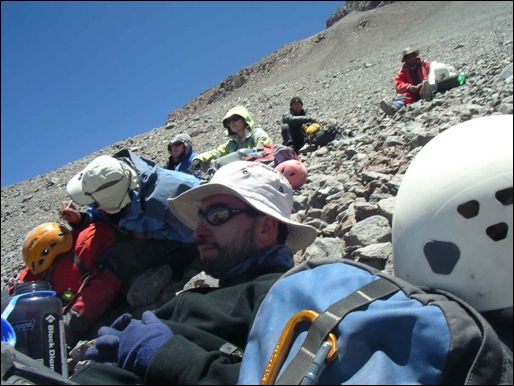
Team resting – training day
This is the best we ever did on that volcano. Even Macario had a whistle of approval. We now admire the view from what will be mid-camp in a couple of days. In the far ground, we see Laguna Lejia where Lee and Edmond are working today. I cannot help but to wave at them, as if they could see me. We are about 10 km away from them and something like 1,200 m above their head. A little farther away, here is Laguna Aguas Calientes nested between lava flows and ash deposits. It is interesting to see all of our study sites at once from this vantage point.
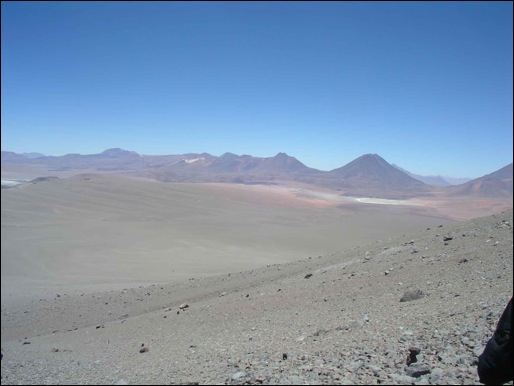
Lagunas from midcamp
They look so close to each other but the difficult dirt trail makes it always a bit of a challenge to reach them. That’s part of the poetry of the whole adventure. Those trails are being crossed sometimes by humans who look a bit lost in here, and more often by herds of llamas, vicunas, guanacos, groups of nandus, pedris, flights of flamingoes and ducks, fast foxes and viscachas, spying on us behind the rocks. Those are funny. They have the head of a rabbit and the rear body of kangaroos. Their size is that of a rabbit though.
To our left, we have Pili, also known as Acamarachi, a perfectly coned-shape volcano of 6,150 m high which seems to have a little pond at it summit. As far as I am concerned, I have climbed enough for today…This pond will wait.
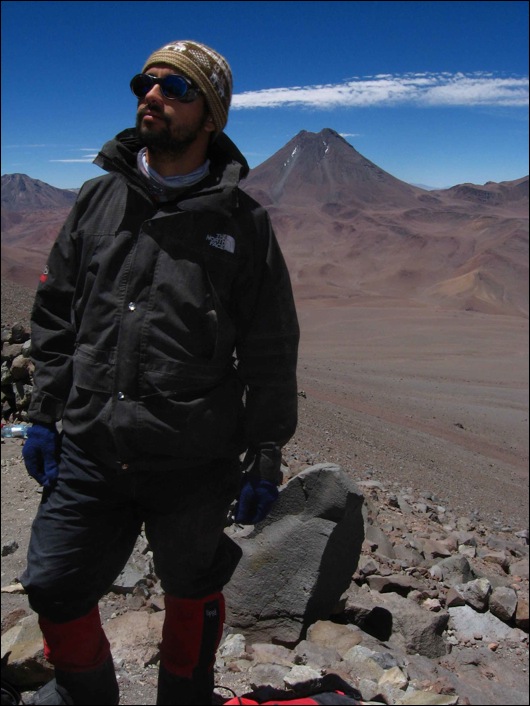
Victor at midcamp with Pili in the background
We stay about 30 minutes at mid-camp, drinking and eating, and talking about the summit. The number of new bees in the team makes it more magical this year for me. I can see the excitement in their eyes and they are flooding me with questions. It is good to see passion and to share it. They want to know everything from how much time it will take us from there to reach the summit, how is the route, to how is the lake.
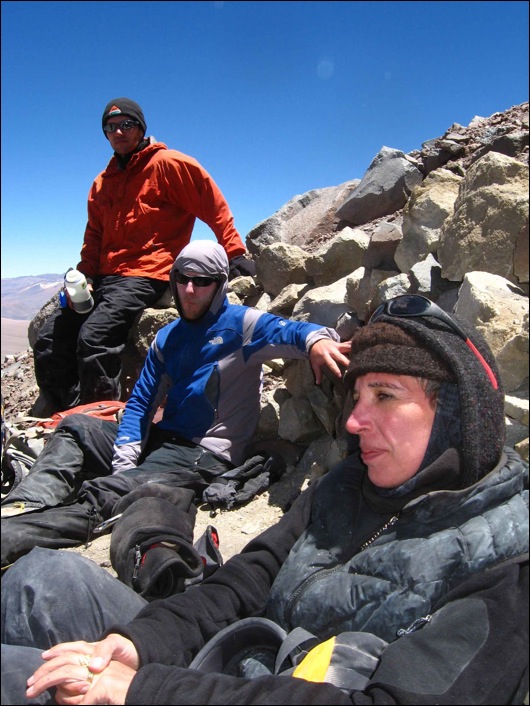
Kevin, Jeremy, and Nathalie at midcamp
As far as the latter, I am trying to keep their expectations low since Macario told me that the lake was in great part frozen. As a result, I do not know how much we will be able to accomplish. Here too, we will take this one day at a time. For me, I am happy to have been able to make it up here today and I am also very happy for being with such a great group of quality young people. All of them have already changed in subtle ways since they arrived and it is good to see. Exposure to extreme, sense of duty and responsibility towards themselves, the group, and the mission’s objectives are turning them into a “band of brothers” (and sisters too!). But they have more. They are genuinely good-hearted human beings and show a rock-solid solidarity. No worries there.
Time to get down. We are taking the “highway” downhill, which means that we are making a B-line in the scree and it takes us about 30 minutes to come back to the cars waiting for us. This was a good day and the training has given me more confidence that the team has recovered and that we can think about making this summit. That makes me happy. All covered in dust, we jump back in the trucks and are hauled back to camp. Some of us will add another layer of dust during that ride. We are too many to all ride inside the 4x4s. Kevin is one of those making the ride outside on the flat bed…He probably will need a knife to remove all this dust from him tonight! ☺.
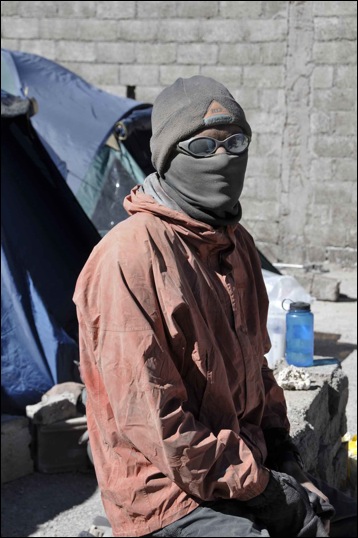
Kevin covered in dust after ride back at camp
At camp our cooks, David and Benita, have prepared a soup and chicken for us. It does not take long to clean our plates! Everyone is relaxed. The training has had the same effect on the team that it had on me. Tomorrow we have another day of science that will be also a way to recuperate and then, on the 18th, we should be on the slope for the final ascent.
Night has fallen on Chillyfornia, true to its name. We are piling on layers and all of us are now wearing headlights. The stars are as big as diamonds and they are rising very fast over the volcanoes. The moon is also playing games of white light and shadows on the surrounding peaks.
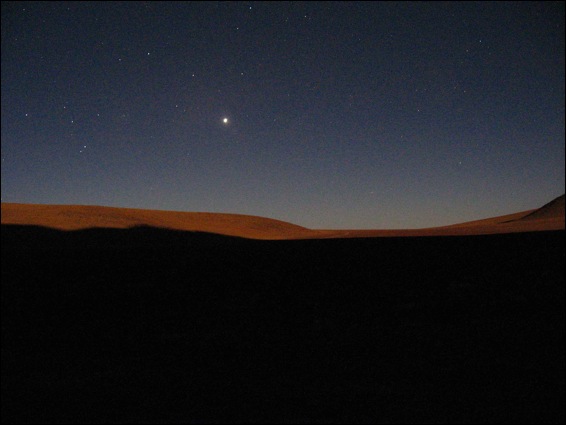
Moonlight and shadows in the altiplano at night
There is so much magic around here and everything is a lot simpler, much harder, and so pure, from the rare air we breathe to the simplicity of life. It is far from being paradise, do not misunderstanding me. Every single living being around here has to fight to make it to tomorrow. We are just a little better equipped to survive than the wildlife around us but we are as fragile. I am thinking about this as I see the camp slowly starts falling asleep. The porters are already sleeping; many of the crew too. Somewhere in the “office”, Eric is studying.
It is time to retire for the day. I can’t stop thinking about the little nandus wondering in the altiplano, their mom being their only protection in a very, very, vast universe whose limits they do not know. Just like them, we keep going and just enjoy the next discovery. The next hill always brings a new perspective. Like us, they are explorers. I hope tonight they are under the warm protection of their mom’s feathers. We have our tents and will seek refuge there for now. Maybe our paths will meet again tomorrow.
Good night from up high,
Nath
The team has come a long way from a challenging start of illnesses and delays to being in the field and doing non-stop science in Laguna Lejia and Salar de Aguas Calientes for close to two weeks now. Still, the next big step is the ascent of the volcano Aguas Calientes, also known as Simbad. Its large crater hosts a ~100 m diameter, round, and deep red lake. We went to Simbad for the first time in 2006 and left an Eldonet UV dosimeter there. In 2007, we came back to retrieve the dosimeter and barely had time to do anything else as a 7.8 magnitude earthquake struck the area at about the same time we were reaching the summit. This year, we do have a science outline for Simbad which is located in an area with exceptional UV flux and yearly ozone evolution. I have to say that I am pretty excited about it.
However, before we can get to the lake, we have to figure out how much damage the various viruses, bacteria, and other cold, dust, and fatigue have done to us. We are all fine now but who knows. It is with that question in mind that I prepare my backpack for today’s exercise, which is to climb to mid-camp on the slope of Simbad and come back to Chillyfornia at night. We will see how much energy we have in reserve. Annoyingly enough, this question is very much of an actuality for me too. A suite of health issues, both small and big, has not spared me and I’ve have a hard time shaking off the fatigue. In this perspective, it has been probably the most challenging expedition since 2002. We’ll see.
That’s well worth it, though, as the science results are unfolding every day in front of us, intriguing in some cases, but deeply interesting all the time. The composition of the team is also helping to make this expedition uniquely exciting. I am always looking forward to our late afternoon and dinner discussions where ideas and theories about our daily findings are shared. Often, ideas for experiments stem from those discussions and they are tested the next day in the field. Science live - nothing can beat this!
Nights are busy with note writing for everybody, watching the slides that the microbiologists make and projecting on the computer screen using our field Proscope microscope, watching the many photographs taken during the day, for science or for simple pleasure of capturing the shear beauty of this primordial landscape. This is our version of the outdoor movie…kind of extreme but frankly, much more fascinating than anything that Hollywood has to offer these days! Of course, that’s a question of personal preferences…☺. We are missing popcorn, though.
Training…Here it comes. I wake up not really feeling like I want to climb that slope for 3 hours. Not a good sign. Then breakfast and preparations with the porters laughing. Today, only some of them will come while the others will rest at camp. We are the ones going up, maybe some sort of altiplanic justice. At any rate, they are having a good time seeing us pack and that’s fair enough. Beside, we are all good friends and it is really more a game than anything else. Macario is always ready. Our faithful guide since 2002 is especially in shape this year. It looks like he has added a turbo to his engine. He climbed Simbad from bottom to top the other day in less than three hours, to the point than even the three porters accompanying him quit at mid-camp! When I think that we will be happy to cut our climb in two with a night sleep at 5,400 m. All right, time to go. Everybody jumps into the pick-up trucks after having piled up the backpacks and poles in the flat beds.
We are on our way now, the trucks raising clouds of dust all around us. We are looking around for nandus and pedris (small birds perfectly camouflage with feathers of the same color as the dirt and a little bit of yellow to mimic the bushes around). They are there and they are abundant this year.
The weather is good. The cold wind of the previous days seems to be calming down. Two nights ago, we had a large black cloud dumping a load of snow on Chillyfornia. The flakes were very small and that did not last more than an hour but was enough to have me worried than an early altiplanic storm could surprise us at mid-camp or at the summit when we will be making the final climb. I am not so worried about the snow but certainly a lot about possible electrical storms. Today is nice so let’s take one day at the time.
It takes us about one hour to get from Chillyfornia to the bottom of the slope. The last kilometers are in very soft terrain and the drivers of our 4x4s have to use all their talent to get us to destination without getting stuck.
We are now on our own. Backpacks and poles, a line of 10 and here we go again…rocks, scree and…good surprise too. The two weeks spent working at 4,500 m in the altiplano seem to have worked their magic for our acclimatization. We climb fast, very fast. The rhythm is good and everybody is in a good mood. At the end of it all, it takes us only two and half hours to reach mid-camp and we stopped only a minimum amount of time!

Team resting – training day
This is the best we ever did on that volcano. Even Macario had a whistle of approval. We now admire the view from what will be mid-camp in a couple of days. In the far ground, we see Laguna Lejia where Lee and Edmond are working today. I cannot help but to wave at them, as if they could see me. We are about 10 km away from them and something like 1,200 m above their head. A little farther away, here is Laguna Aguas Calientes nested between lava flows and ash deposits. It is interesting to see all of our study sites at once from this vantage point.

Lagunas from midcamp
They look so close to each other but the difficult dirt trail makes it always a bit of a challenge to reach them. That’s part of the poetry of the whole adventure. Those trails are being crossed sometimes by humans who look a bit lost in here, and more often by herds of llamas, vicunas, guanacos, groups of nandus, pedris, flights of flamingoes and ducks, fast foxes and viscachas, spying on us behind the rocks. Those are funny. They have the head of a rabbit and the rear body of kangaroos. Their size is that of a rabbit though.
To our left, we have Pili, also known as Acamarachi, a perfectly coned-shape volcano of 6,150 m high which seems to have a little pond at it summit. As far as I am concerned, I have climbed enough for today…This pond will wait.

Victor at midcamp with Pili in the background
We stay about 30 minutes at mid-camp, drinking and eating, and talking about the summit. The number of new bees in the team makes it more magical this year for me. I can see the excitement in their eyes and they are flooding me with questions. It is good to see passion and to share it. They want to know everything from how much time it will take us from there to reach the summit, how is the route, to how is the lake.

Kevin, Jeremy, and Nathalie at midcamp
As far as the latter, I am trying to keep their expectations low since Macario told me that the lake was in great part frozen. As a result, I do not know how much we will be able to accomplish. Here too, we will take this one day at a time. For me, I am happy to have been able to make it up here today and I am also very happy for being with such a great group of quality young people. All of them have already changed in subtle ways since they arrived and it is good to see. Exposure to extreme, sense of duty and responsibility towards themselves, the group, and the mission’s objectives are turning them into a “band of brothers” (and sisters too!). But they have more. They are genuinely good-hearted human beings and show a rock-solid solidarity. No worries there.
Time to get down. We are taking the “highway” downhill, which means that we are making a B-line in the scree and it takes us about 30 minutes to come back to the cars waiting for us. This was a good day and the training has given me more confidence that the team has recovered and that we can think about making this summit. That makes me happy. All covered in dust, we jump back in the trucks and are hauled back to camp. Some of us will add another layer of dust during that ride. We are too many to all ride inside the 4x4s. Kevin is one of those making the ride outside on the flat bed…He probably will need a knife to remove all this dust from him tonight! ☺.

Kevin covered in dust after ride back at camp
At camp our cooks, David and Benita, have prepared a soup and chicken for us. It does not take long to clean our plates! Everyone is relaxed. The training has had the same effect on the team that it had on me. Tomorrow we have another day of science that will be also a way to recuperate and then, on the 18th, we should be on the slope for the final ascent.
Night has fallen on Chillyfornia, true to its name. We are piling on layers and all of us are now wearing headlights. The stars are as big as diamonds and they are rising very fast over the volcanoes. The moon is also playing games of white light and shadows on the surrounding peaks.

Moonlight and shadows in the altiplano at night
There is so much magic around here and everything is a lot simpler, much harder, and so pure, from the rare air we breathe to the simplicity of life. It is far from being paradise, do not misunderstanding me. Every single living being around here has to fight to make it to tomorrow. We are just a little better equipped to survive than the wildlife around us but we are as fragile. I am thinking about this as I see the camp slowly starts falling asleep. The porters are already sleeping; many of the crew too. Somewhere in the “office”, Eric is studying.
It is time to retire for the day. I can’t stop thinking about the little nandus wondering in the altiplano, their mom being their only protection in a very, very, vast universe whose limits they do not know. Just like them, we keep going and just enjoy the next discovery. The next hill always brings a new perspective. Like us, they are explorers. I hope tonight they are under the warm protection of their mom’s feathers. We have our tents and will seek refuge there for now. Maybe our paths will meet again tomorrow.
Good night from up high,
Nath
Captain’s Log No. 3 – A Tale of Survival
11/15/08 11:37
November 11-14, 2008
Science is now going full steam in the altiplano (no pun intended for Lascar). When I look at this team and the expertise present, it is clear that this year represents the most integrated science in the field. This is not surprising as the project has matured and our objectives are clearer. The central objective is still to understand how increased UV impacts life and along this six year journey: geologists, geophysicists, microbiologists, limnologists, and UV ecologists have joined the High Lakes Project. This year, all these disciplines are represented. This is the most unique and the greatest strength of Astrobiology. Each of these team members brings their own perspective, and when combined, they offer a more profound vision to our question.
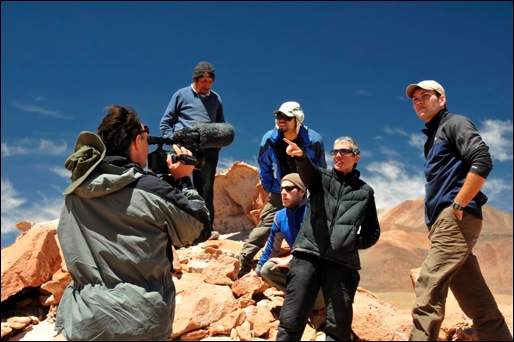
First day in the field – Nathalie pointing to Laguna Lejia
So many lakes and so little time and for “Cookie” (Ingrid), our fearless geologist, so many volcanoes, so little time. She tells us about the history of the parent-rocks of the sediments we collect in the lakes, their changes through time, sometimes about the fury of the volcanoes which entombs life in the lakes for decades after an eruption. This is the case for Laguna Lejia, too close to the volcano Lascar for comfort. The ecosystem in the lake is barely recovering from the last eruption of 1993.
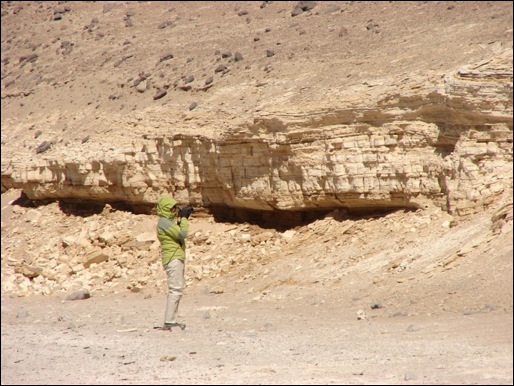
Ingrid studying the stratigraphy of Laguna Lejia’s ancient terraces
Erich and Eric, one from Ames and one from UCN Antofagasta, along with Lee, also from Ames, investigate the lakes in search of clues about microbial life, its adaptation – or lack thereof- to UV 170% higher than sea level, ozone level below ozone hole definition (40% depletion) for 36 days per year on average and between 25-35% depletion the rest of the year. Temperature daily variability can reach 50 degrees Celsius, aridity averages 30% but values around 10% are far from rare. An almost exclusively volcanic and lacustrine environment gives our sites an air of early Mars or early Earth.
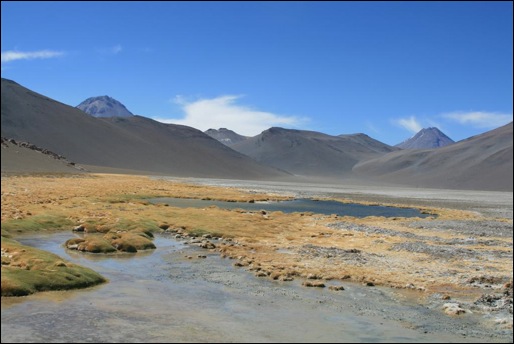
Laguna Aguas Calientes with Simbad and Pili Volcanoes in the background
Understanding how life survives here provides clues not only to document the question of life and its survival potential on Mars in the past but also points toward our own past, our own journey from a time when life on Earth was barely hanging, a fragile miracle in an adverse environment of no ozone and constant impact bombardment to today, when life has become complex and advanced enough that it starts asking questions about its own origin.
How does climate variability affect habitability and diversity? What kind of changes does it trigger and how fast? Kevin, Jeremy, Edmond and myself are trying to document this point, Edmond and I by documenting the geophysical and meteorological environment, assisted by Jutson, Kevin and Jeremy by looking at the consequences of climate variability in the water column.
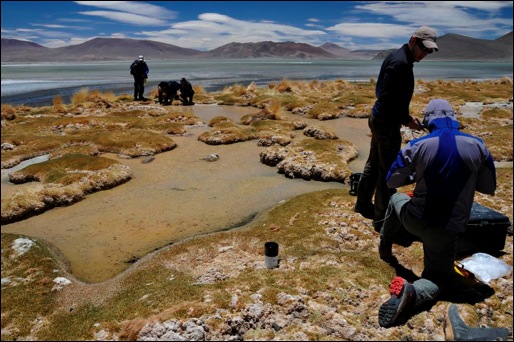
Team at work at Aguas Calientes. From r to l: Jeremy, Kevin, Nathalie, Erich & Eric
We have seen the chemistry of these lakes change yearly in a significant fashion for the past 6 years. Still, life keeps up, at least so far. We do not have the data yet to tell how life’s diversity is affected by this variability. What we observe is that life is present and some species have very dense populations, such as some species of zooplankton and many species of algae. They seem, to all of us, to have presented adaptation strategies against UV, some totally counter-intuitive. They hold important clues for our past and our future, and that of other planets. Tirelessly, we sample, analyze, question, and sample again in an infinite spiral that gathers knowledge along the way and raises even more questions.
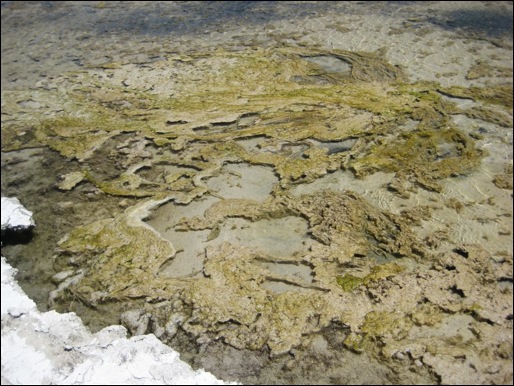
Microbial mat at Aguas Calientes
In the process, we become more integrated into a unique landscape that little by little reveals other wonders as important as our quest, still talking about life’s survival and perpetuation. Three days ago, as we arrived on the shores of Laguna Aguas Calientes for a full day of science there, we witnessed a unique spectacle, unfortunately so foreign to the city dwellers we all are. Our pick-up trucks stopped about 50 meters away from two ñandus, probably two females which ran away into the hills as we approached. We soon realized that while running, they had left behind a little crew of 13 chicks led by the inevitable fearless little leader. They were obviously distressed by the disappearance of their moms and the presence of these strange creatures, two-legged ones just like them but with no feathers (expect maybe for Edmond’s down jacket). They were about 40 cm high, with dark and grey feathers and running everywhere. We left them behind with regret but decided not to disturbed them anymore.
We reached the shore of the lake where we started to prepare for sampling, donning waders, grabbing our plankton nets and our sample bottles, our multi-parameter meter to analyze the water chemistry and the radiometer to analyze UV. Then, something totally unexpected happened. The little guys, all 13 of them, showed up on the shore and went right for Macario, our guide. I do not know if this happened because Macario was wearing a sweater which its dark color could have reminded them of their moms. Anyway, here is Macario at the head of a 13-strong crew, whistling them back towards land and as on cue, the feathered team started to follow him…Priceless! They finally decided to stay far away from the water. During the day, we could see the moms higher in the hills observing us. They must have come back to claim their little gang after we left because when we came back two days later, moms and chicks were nowhere to be seen.
This little gang represents another face of the tale of life’s survival. They are still fragile but resilient and resourceful. They may err along the way but they have already in them this force to prevail no matter what and they give us a message of hope for the future of our planet.
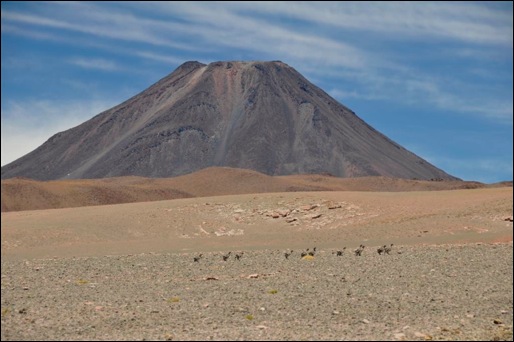
Fearless baby ñandus in the vast Altiplano, Chiliques Volcano in the background
Good night from up high,
Nath
Science is now going full steam in the altiplano (no pun intended for Lascar). When I look at this team and the expertise present, it is clear that this year represents the most integrated science in the field. This is not surprising as the project has matured and our objectives are clearer. The central objective is still to understand how increased UV impacts life and along this six year journey: geologists, geophysicists, microbiologists, limnologists, and UV ecologists have joined the High Lakes Project. This year, all these disciplines are represented. This is the most unique and the greatest strength of Astrobiology. Each of these team members brings their own perspective, and when combined, they offer a more profound vision to our question.

First day in the field – Nathalie pointing to Laguna Lejia
So many lakes and so little time and for “Cookie” (Ingrid), our fearless geologist, so many volcanoes, so little time. She tells us about the history of the parent-rocks of the sediments we collect in the lakes, their changes through time, sometimes about the fury of the volcanoes which entombs life in the lakes for decades after an eruption. This is the case for Laguna Lejia, too close to the volcano Lascar for comfort. The ecosystem in the lake is barely recovering from the last eruption of 1993.

Ingrid studying the stratigraphy of Laguna Lejia’s ancient terraces
Erich and Eric, one from Ames and one from UCN Antofagasta, along with Lee, also from Ames, investigate the lakes in search of clues about microbial life, its adaptation – or lack thereof- to UV 170% higher than sea level, ozone level below ozone hole definition (40% depletion) for 36 days per year on average and between 25-35% depletion the rest of the year. Temperature daily variability can reach 50 degrees Celsius, aridity averages 30% but values around 10% are far from rare. An almost exclusively volcanic and lacustrine environment gives our sites an air of early Mars or early Earth.

Laguna Aguas Calientes with Simbad and Pili Volcanoes in the background
Understanding how life survives here provides clues not only to document the question of life and its survival potential on Mars in the past but also points toward our own past, our own journey from a time when life on Earth was barely hanging, a fragile miracle in an adverse environment of no ozone and constant impact bombardment to today, when life has become complex and advanced enough that it starts asking questions about its own origin.
How does climate variability affect habitability and diversity? What kind of changes does it trigger and how fast? Kevin, Jeremy, Edmond and myself are trying to document this point, Edmond and I by documenting the geophysical and meteorological environment, assisted by Jutson, Kevin and Jeremy by looking at the consequences of climate variability in the water column.

Team at work at Aguas Calientes. From r to l: Jeremy, Kevin, Nathalie, Erich & Eric
We have seen the chemistry of these lakes change yearly in a significant fashion for the past 6 years. Still, life keeps up, at least so far. We do not have the data yet to tell how life’s diversity is affected by this variability. What we observe is that life is present and some species have very dense populations, such as some species of zooplankton and many species of algae. They seem, to all of us, to have presented adaptation strategies against UV, some totally counter-intuitive. They hold important clues for our past and our future, and that of other planets. Tirelessly, we sample, analyze, question, and sample again in an infinite spiral that gathers knowledge along the way and raises even more questions.

Microbial mat at Aguas Calientes
In the process, we become more integrated into a unique landscape that little by little reveals other wonders as important as our quest, still talking about life’s survival and perpetuation. Three days ago, as we arrived on the shores of Laguna Aguas Calientes for a full day of science there, we witnessed a unique spectacle, unfortunately so foreign to the city dwellers we all are. Our pick-up trucks stopped about 50 meters away from two ñandus, probably two females which ran away into the hills as we approached. We soon realized that while running, they had left behind a little crew of 13 chicks led by the inevitable fearless little leader. They were obviously distressed by the disappearance of their moms and the presence of these strange creatures, two-legged ones just like them but with no feathers (expect maybe for Edmond’s down jacket). They were about 40 cm high, with dark and grey feathers and running everywhere. We left them behind with regret but decided not to disturbed them anymore.
We reached the shore of the lake where we started to prepare for sampling, donning waders, grabbing our plankton nets and our sample bottles, our multi-parameter meter to analyze the water chemistry and the radiometer to analyze UV. Then, something totally unexpected happened. The little guys, all 13 of them, showed up on the shore and went right for Macario, our guide. I do not know if this happened because Macario was wearing a sweater which its dark color could have reminded them of their moms. Anyway, here is Macario at the head of a 13-strong crew, whistling them back towards land and as on cue, the feathered team started to follow him…Priceless! They finally decided to stay far away from the water. During the day, we could see the moms higher in the hills observing us. They must have come back to claim their little gang after we left because when we came back two days later, moms and chicks were nowhere to be seen.
This little gang represents another face of the tale of life’s survival. They are still fragile but resilient and resourceful. They may err along the way but they have already in them this force to prevail no matter what and they give us a message of hope for the future of our planet.

Fearless baby ñandus in the vast Altiplano, Chiliques Volcano in the background
Good night from up high,
Nath
Captain’s Log No. 2 – Microbes: The Good, the Bad, and the Ugly…
11/14/08 18:24
November 7-10, 2008
Well, let’s start with the ugly…The beginning of the expedition was marked by an unusual number of team members being sick, including yours truly…and I mean it, sick with antibiotics needed! This has never happened to me in the 7 years of having this expedition. I guess there is a first time for everything.
It is a good thing that we have a doctor on the team and she has been very busy the first week. Jut was the first to be hit and then the bug started to spread; even though Jut was in San Pedro recovering. Then my turn…Sore throat, congestion…unhappy me but with a good doctor, the sun of the altiplano, and so many lakes to deal with, everything is now back to normal. Other than that, I am not sure that anyone of us has escaped some level of this bug, whatever it is. That’s for the bad microbes. But now, everybody is well and this episode has not decreased the productivity of the team, far from that…Now for the good microbes…They are everywhere and this is why we are here.
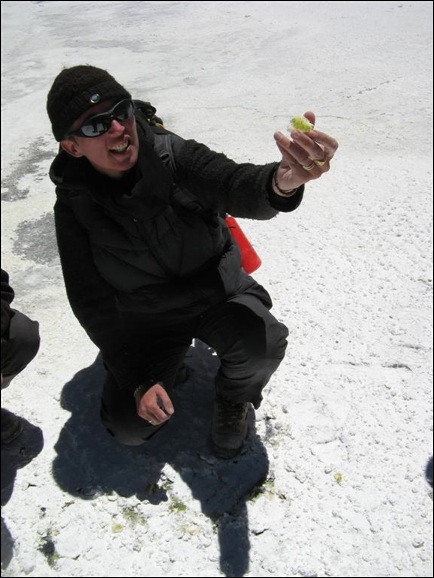
Nathalie showing a sample of subsurface microbial life on the shore of Laguna Lejia
We have settled in Chillyfornia, on the Chilean side of the altiplano. We had a warm welcome from the volcano Lascar. Quiet until our arrival, it has started to show some venting activity. I am starting to wonder if it did not recognize us after its last year’s tantrum (see HLP 2007 ). Nothing alarming, just volutes of water vapor. Still…
Chillyfornia is our home away from home. The camp is remarkably organized thanks to the logistical talent of Cristian and Victor and also to the energy of the entire team who took only two hours to set it up. Our “office” at 4,200 m is equipped with a satellite phone and internet connection – which I am proud to say is faster than any connection in San Pedro- (Edmond’s explanation is that we are closer to the satellites in space). The office doubles as a medical room, which was fairly busy last week due to the rampaging bug and the daily medical exams of the team by the good doctor Claudia, who is fantastic. You never feel sick no matter how bad you are. She always laughs. Of course, she is an ER doctor so I suppose that a few colds are not that scary to her. She is running after us for her physiological exams daily, which proves that we still have enough energy to try to escape her.
The office is a good place to convene at night after dinner. The team goes through the daily data, views photos shot during the day, or to simply chat.
The other central place is the dinning room. This is the largest tent in the camp. This year we have two cooks, David (who was with us last year) and his charming wife, always smiling Benita, who serves as his assistant. David is a great cook and the team is grateful for that. Nothing like warm soup at 5:00 pm to welcome the team back to camp when we are returning from the field. We are exposed all day long to the assaults of the altiplanic wind, the cold temperatures, and the salt of the lakes and this is a nice pause before going through the samples and all the data collected. We share this space with the porters, guides, and drivers, which makes for a good crowd. We are about 20 people total this year. A little community in the middle of the altiplano, only surrounded by the breathtaking beauty of the volcanoes, the sun setting on lava flows, the moon light at night on those peaks and the millions of stars larger than plates in the sky, diamond beaconing in the crisp night.

Chillyfornia camp panorama
In the past few days, the Nandus (large birds that look like ostriches) have become more curious about us. Yesterday, as we were coming back, three large birds were getting closer to the camp. They saw the pick-up trucks and ran like kids caught red-handed in the cookie jar. I would not be surprised to find one peaking in on a tent in the morning. It seems to be a good year for them (see also Captain’s Log No.3). They are abundant and females run in the altiplano with an average of 6 chicks in tow… priceless.
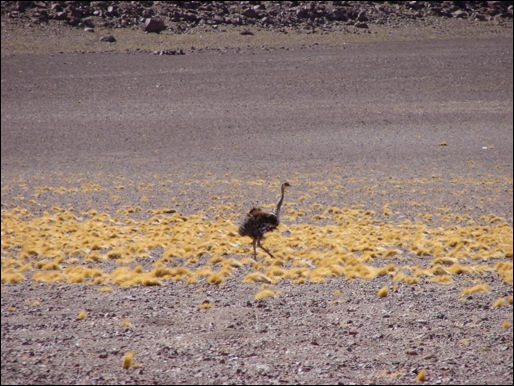
Ñandu running
Vicunas and llamas are also present as are goats and wild donkeys: So much life in such an arid and desolated area. This is where it all comes back to mind. How do they survive? How come they still can be here? Water is an essential clue. The lakes we are studying are central to their survival and they are disappearing. When we started the High Lakes Project, our first objective was to understand how climate change on Mars and increased UV could have impacted the habitability of ancient martian lakes 3.5 billion years ago. Today, six years later, while we have made significant progress in our understanding of this question thanks to a unique terrestrial analog in the altiplano, we have stumbled into something else, something of urgent actuality that touches us and our planet now. Climate is changing here and now. How does this climate change, the fading water column of these lakes, and the increased effect of UV impact habitability in the altiplanic lakes and the ecosystems that survived in and around those lakes?
From Earth to Mars and back to Earth. The circle is far from being completed. This journey is just starting. The echo of a declining habitability on Mars 3.5 billion years ago is haunting us in the altiplano and all around the globe for that matter. However, Chile and Bolivia are amongst the countries most affected by current changes: In 50 years, Chile has lost 50% of its precipitation; Glaciers in Bolivia, Chile, and Argentina have retreated 7 times faster in the past 15 years than ever before. The high lakes are telling us a tale of changing planets, either here and now or back on Mars then. They are a time machine propelling us into the past of Mars and into Earth’s future. Although fading away, these natural laboratories are delivering us a message of hope, one of life’s survival no matter what, a message delivered by the data and the samples we collect everyday.
Good night from up high,
Nath
Well, let’s start with the ugly…The beginning of the expedition was marked by an unusual number of team members being sick, including yours truly…and I mean it, sick with antibiotics needed! This has never happened to me in the 7 years of having this expedition. I guess there is a first time for everything.
It is a good thing that we have a doctor on the team and she has been very busy the first week. Jut was the first to be hit and then the bug started to spread; even though Jut was in San Pedro recovering. Then my turn…Sore throat, congestion…unhappy me but with a good doctor, the sun of the altiplano, and so many lakes to deal with, everything is now back to normal. Other than that, I am not sure that anyone of us has escaped some level of this bug, whatever it is. That’s for the bad microbes. But now, everybody is well and this episode has not decreased the productivity of the team, far from that…Now for the good microbes…They are everywhere and this is why we are here.

Nathalie showing a sample of subsurface microbial life on the shore of Laguna Lejia
We have settled in Chillyfornia, on the Chilean side of the altiplano. We had a warm welcome from the volcano Lascar. Quiet until our arrival, it has started to show some venting activity. I am starting to wonder if it did not recognize us after its last year’s tantrum (see HLP 2007 ). Nothing alarming, just volutes of water vapor. Still…
Chillyfornia is our home away from home. The camp is remarkably organized thanks to the logistical talent of Cristian and Victor and also to the energy of the entire team who took only two hours to set it up. Our “office” at 4,200 m is equipped with a satellite phone and internet connection – which I am proud to say is faster than any connection in San Pedro- (Edmond’s explanation is that we are closer to the satellites in space). The office doubles as a medical room, which was fairly busy last week due to the rampaging bug and the daily medical exams of the team by the good doctor Claudia, who is fantastic. You never feel sick no matter how bad you are. She always laughs. Of course, she is an ER doctor so I suppose that a few colds are not that scary to her. She is running after us for her physiological exams daily, which proves that we still have enough energy to try to escape her.
The office is a good place to convene at night after dinner. The team goes through the daily data, views photos shot during the day, or to simply chat.
The other central place is the dinning room. This is the largest tent in the camp. This year we have two cooks, David (who was with us last year) and his charming wife, always smiling Benita, who serves as his assistant. David is a great cook and the team is grateful for that. Nothing like warm soup at 5:00 pm to welcome the team back to camp when we are returning from the field. We are exposed all day long to the assaults of the altiplanic wind, the cold temperatures, and the salt of the lakes and this is a nice pause before going through the samples and all the data collected. We share this space with the porters, guides, and drivers, which makes for a good crowd. We are about 20 people total this year. A little community in the middle of the altiplano, only surrounded by the breathtaking beauty of the volcanoes, the sun setting on lava flows, the moon light at night on those peaks and the millions of stars larger than plates in the sky, diamond beaconing in the crisp night.

Chillyfornia camp panorama
In the past few days, the Nandus (large birds that look like ostriches) have become more curious about us. Yesterday, as we were coming back, three large birds were getting closer to the camp. They saw the pick-up trucks and ran like kids caught red-handed in the cookie jar. I would not be surprised to find one peaking in on a tent in the morning. It seems to be a good year for them (see also Captain’s Log No.3). They are abundant and females run in the altiplano with an average of 6 chicks in tow… priceless.

Ñandu running
Vicunas and llamas are also present as are goats and wild donkeys: So much life in such an arid and desolated area. This is where it all comes back to mind. How do they survive? How come they still can be here? Water is an essential clue. The lakes we are studying are central to their survival and they are disappearing. When we started the High Lakes Project, our first objective was to understand how climate change on Mars and increased UV could have impacted the habitability of ancient martian lakes 3.5 billion years ago. Today, six years later, while we have made significant progress in our understanding of this question thanks to a unique terrestrial analog in the altiplano, we have stumbled into something else, something of urgent actuality that touches us and our planet now. Climate is changing here and now. How does this climate change, the fading water column of these lakes, and the increased effect of UV impact habitability in the altiplanic lakes and the ecosystems that survived in and around those lakes?
From Earth to Mars and back to Earth. The circle is far from being completed. This journey is just starting. The echo of a declining habitability on Mars 3.5 billion years ago is haunting us in the altiplano and all around the globe for that matter. However, Chile and Bolivia are amongst the countries most affected by current changes: In 50 years, Chile has lost 50% of its precipitation; Glaciers in Bolivia, Chile, and Argentina have retreated 7 times faster in the past 15 years than ever before. The high lakes are telling us a tale of changing planets, either here and now or back on Mars then. They are a time machine propelling us into the past of Mars and into Earth’s future. Although fading away, these natural laboratories are delivering us a message of hope, one of life’s survival no matter what, a message delivered by the data and the samples we collect everyday.
Good night from up high,
Nath
Challenging Journey
11/08/08 09:09

Today sees us back in San Pedro, ready to move to Chillyfornia to start working at our Chilean sites. Our stay at the refuge will have lasted only four days, four days during which we roamed the altiplano back and forth to Uyuni for a visa and waited to hear about an authorization to start work that is not coming. We entered Bolivia counting on the authorization arriving last Tuesday, then Wednesday, then… I had to make a decision as we could not waste much more time waiting. We had already lost three days and could not afford more.
Our Bolivian scientific partners are sorry about this situation but they do not have the power of decision. Apparently, bigger forces than science are at play here and the relationships between the US and Bolivia have been tense in the past few months. We are just caught in the middle of a situation much bigger than us. Our Bolivian partners are still trying to make it happen and we are extremely grateful for the support we have received from the Park Rangers, the Institute of Ecology, and SERNAP in trying to resolve this visa problem. Meanwhile, I am taking the team back to Chile and we will start our investigation from there in a few hours. At this point in time, it is just a matter of flipping our program: Chile first, Bolivia second. We can accommodate the few days loss. If things get resolved in Bolivia, we will return to the refuge in about 8 days and climb Licancabur; if not, we will have time to make an in-depth analysis of the Chilean sites. Despite politics, science will still come out a winner.
Politics has not been our only challenge. A nasty bug has struck the team at various levels and our doctor has been very busy. One of our team members, unfortunately, has been stuck in San Pedro for most of the time now, recovering. We will see if antibiotics can resolve the bug or if we are dealing with a virus, in which case, going back home could be the best solution for him.
The silver lining of these first few days is definitely the behavior of the team composed, for most part, of young scientists, grad, doctoral, and post-doc students. For them, this is their first expedition and their first time in South America. They could already see the complexity and the challenges that can accompany such an endeavor and they have taken with them enthusiasm and patience. I am the captain of a strong ship, an even stronger crew who is not afraid of challenging waters…but who said exploration had to be easy?
On a more personal note, I would say that our administrative trip to Uyuni to obtain a visa was a blessing in disguise. Uyuni is 400 km from the refuge, the dirty trails of the altiplano soon being replaced by, well, the altiplano. Volcanoes, rocks, dust, springs, and high desert. Blue lakes alternate with the blood-red waters of Laguna Colorada.
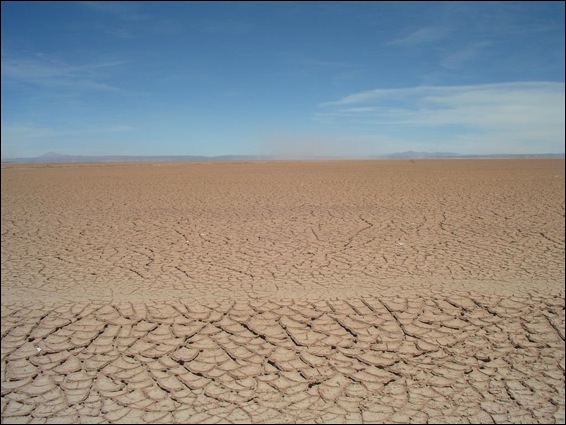
I know this place. I crossed the altiplano with the 2005 expedition but still, the feeling of recognition is deeper. Maybe Mars could have looked like that some 3.5 billion years ago. Kilometers of trails soon turn into tens of kilometers of trails. No habitations, no structures, only the altiplano…or maybe not. Coming out from a curve, the car passes a woman carrying her baby on her back. She is dressed in typical inca clothing and obviously is coming back from the river where she gave her baby a bath. We still drove another 15 km before seeing the first house. I could not help but think that in case of an asteroid striking the Earth, I have a good sense of who would survive. The image of this woman brings me back to the reality of why we are here.
Looking all around us, in the altiplano, life is a matter of survival, whether at microscale or at macroscale. The simplest living species, such as the cyanobacteria colonizing the springs here and they are now sharing the same expand of land than the most advanced being Earth has ever carried: The Human species. In the altiplano, I am not sure which one is doing the best but both have learned to survive with what they have.
-Nathalie Cabrol
Message from Kevin & Jeremy
11/06/08 16:26
November 3, 2008
Today we travelled from San Pedro de Atacama to the Refuge at Laguna Blanca. As someone that works in the desert, I thought I
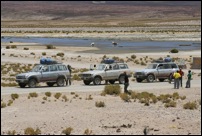
We continued to climb into thinner air and we were soon faced with a closer view of Licancabur and for a member of his inaugural expedition this view was as magnificent as it was daunting. After a quick team photo, we continued to the Refuge following stops at the Bolivian customs and the entrance to the national park. The Refuge, while rustic, offered the comforts of home at ~4,400 m. We were protected from the hard blowing wind and sub-zero temperatures; we had bunks to lay our heads; we had attached, working bathrooms; and we had hot, home cooked meal from Maxima (our refuge mother) that was a delight to our hungry, tired bodies. We arrived with enough daylight to walk to the edge of Laguna Blanca where we were welcomed by a flock of flamingos.

The walk back to the Refuge, though short, was quite demanding on the lungs. All of the aspects of this trip were now in place; life in an extreme environment. Our goals for the next few weeks will be to better understand the interaction between the two, but for now we will rest and allow our bodies to acclimate to the conditions.
November 4-5, 2008
Over the past two days, the United States has elected a new president and the crew here has done its fair share of driving while exploring the Altiplano and Bolivian culture. We departed our home at the Refuge early on Election Day for a 400 km drive to the town of Ujuni, where we could pay the appropriate fees and get visas. The main road, in fact the only road, was a dirt highway exactly the size of two vehicles, but some areas would probably have tested the geometry of that statement. Although we were bounced around and covered in dust, the drive was a fulfilling experience both scientifically and culturally. We stopped at Laguna Colorada where we were able to observe and photograph the large flocks of flamingos that utilize this body of water for nesting before seeking warmer weather when the weather here turns harsh. The laguna offered spectacular photographs of Colorada’s red waters and volcanic landscape; however, the noticeable, shrinking water line brought as back to the stark reality of the impact of climate change on these systems, which for the flamingos means the loss of a vital habitat.
Throughout our drive, we passed the skeletons of former lake systems, which may offer a glimpse into the future of the shrinking lakes if the climate continues on its current path. We also passed many small towns along the way. In these, men, women, and children were going about their business in the driest place on Earth. Each of these small communities seemed based around some small, yet vital source of water. Water’s life giving properties were visible as the driest areas were also the most lifeless and it seemed like every drop was utilized in some functional way.
After arriving in Uyuni, we fulfilled our payments and spent the night in a local hotel to recharge our batteries before our 400 km drive home. We arrived back at the Refuge just as the setting sun was painting the distant mountains and volcanoes full with color and Maxima was setting the table with nourishing food. Our dusty bodies, tired from the baking sun and bouncing dirt roads, were now full and happy to quickly collapse into bed…
-Kevin Rose & Jeremy Mack
Miami University article on HLP
11/06/08 11:46
Miami student part of NASA expedition to study climate
change
Source: Miami University
http://www.miami.muohio.edu/news/article/view/6305
Source: Miami University
http://www.miami.muohio.edu/news/article/view/6305
Arrived Safely in Antofagasta
10/30/08 09:34
The troop has arrived in Chile. Everything went very
smoothly. All planes were right on time and the customs
almost non existing. We found Jut and Jeremy as
expected in SJC, Gordon at LAX and finally Kevin this
morning in Santiago. He was right behind us. Cristian
was waiting for us in Antofagasta with a van and now
everyone is settling in at the hotel.
-Nathalie Cabrol
-Nathalie Cabrol
Equipment has Cleared Chilean Customs
10/24/08 16:10
Just received the good news from our shipper that the
equipment has cleared Customs in Chile! It took a total
of 19 days from our door to exiting Customs.
Travel Information
10/22/08 13:19
Nathalie and her team will be heading to Antofagasta
Chile on October 29th. This flight is over 15 hours
long and has stops in Los Angeles, Lima, Santiago and
Antofagasta.
Along with the expedition team, 27 bins of camping and science equipment are en route.
Along with the expedition team, 27 bins of camping and science equipment are en route.
Team Members
09/24/08 13:26
Nathalie Cabrol
Principal Investigator, SETI Institute and NASA ARC, Space Science & Astrobiology Division, USA
Lee Bebout, NASA Ames Research Center, USA
Gordon Brown, Discovery Channel, USA
Guillermo Chong, Universidad Católica del Norte, Chile
Cecilia Demergasso, Universidad Católica del Norte, Chile
Erich Fleming, NASA Ames Research Center and Oak Ridge Associated Universities, USA
Victor Gaete, Universidad Católica del Norte, Chile
Edmond Grin, SETI Institute and NASA ARC, Space Science & Astrobiology Division, USA
Jeremy Mack, U.S. Geological Survey and Miami University at Ohio, USA
Ingrid Peate, Dept. of Geosciences, University of Iowa, USA
Claudia Perez, M.D. Clinica las Condes Santiago, Chile
Eric Pinto, Universidad Católica del Norte, Chile
Julio Pinto, Institute de Ecolgia, Universidad Major de San Andres, Bolivia
Kevin Rose, Department of Zoology, Miami University at Ohio, USA
Cristian Tambley, CHEP, Chile
J. Judson Wynne, Dept. of Biological Sciences, Northern Arizona University, SETI Institute, USA
Lyn Bartlett
Logistics, SETI Institute and NASA ARC, Space Science & Astrobiology Division, USA
Principal Investigator, SETI Institute and NASA ARC, Space Science & Astrobiology Division, USA
Lee Bebout, NASA Ames Research Center, USA
Gordon Brown, Discovery Channel, USA
Guillermo Chong, Universidad Católica del Norte, Chile
Cecilia Demergasso, Universidad Católica del Norte, Chile
Erich Fleming, NASA Ames Research Center and Oak Ridge Associated Universities, USA
Victor Gaete, Universidad Católica del Norte, Chile
Edmond Grin, SETI Institute and NASA ARC, Space Science & Astrobiology Division, USA
Jeremy Mack, U.S. Geological Survey and Miami University at Ohio, USA
Ingrid Peate, Dept. of Geosciences, University of Iowa, USA
Claudia Perez, M.D. Clinica las Condes Santiago, Chile
Eric Pinto, Universidad Católica del Norte, Chile
Julio Pinto, Institute de Ecolgia, Universidad Major de San Andres, Bolivia
Kevin Rose, Department of Zoology, Miami University at Ohio, USA
Cristian Tambley, CHEP, Chile
J. Judson Wynne, Dept. of Biological Sciences, Northern Arizona University, SETI Institute, USA
Lyn Bartlett
Logistics, SETI Institute and NASA ARC, Space Science & Astrobiology Division, USA